First Nations
languages around the country
Words and Phrases
- barramundi ∼ barra
- a large freshwater fish
 A silvery-grey food fish of excellent quality, Lates Calcarifer is found in coastal rivers and estuaries of tropical northern Australia and the Indo‑Pacific.
A silvery-grey food fish of excellent quality, Lates Calcarifer is found in coastal rivers and estuaries of tropical northern Australia and the Indo‑Pacific.
- bilby
- either of two australian bandicoots
 Especially the rabbit-eared bandicoot Macrotis lagotis, a burrowing marsupial of woodlands and plains of drier parts of mainland Australia.
Especially the rabbit-eared bandicoot Macrotis lagotis, a burrowing marsupial of woodlands and plains of drier parts of mainland Australia.
There were originally two species but the Greater Bilby is now commonly referred to simply as 'the Bilby' because the Lesser Bilby Macrotis leucura became extinct in the early 1950's.
They feature in the songs and stories of First Nations people, who refer to them by up to 20 different names.
Also known as dalgyte in Western Australia and pinky in South Australia.
- billabong
- a pool or lagoon
 This word translates to:
This word translates to:
dead river – when the water flow ceases
with Bila meaning river and Bong / Bung meaning dead.
- boobialla
- salt-tolerant fruiting shrub
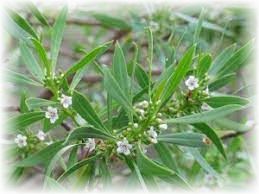 Boobialla varies in form from a prostrate shrub to a small, erect tree growing to a height of 6m (20 ft). The purple fruit is edible, and is good for making jams and jellies.
Boobialla varies in form from a prostrate shrub to a small, erect tree growing to a height of 6m (20 ft). The purple fruit is edible, and is good for making jams and jellies.
- boobook
- type of owl
- boorie, jarjum
- boy, child
- brolga
- one of australia's largest flying birds

- bung
- incapacitated, exhausted, broken
- My car has gone bung.
- bunji
- mate, close friend, kinsman
- bunyip
- a mythical man-eating amphibious beast
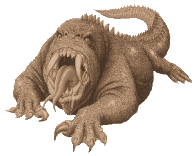
Said to inhabit rivers and deep pools, it is not to be confused with the yowie.
- charge-up, charge
- drink alcohol
- cooee ∼ within cooee
- come here, at hand, imminent
- Are we within cooee of getting this done?
- coolamon
- wooden vessel
- Used to hold liquids or babies.
- corella
- white cockatoo
- corroboree
- sacred or festive assembly
- country
- land, home
- deadly
- excellent, fantastic, cool
- Deadly is used by many Aboriginal people to mean excellent, or very good, in the same way that wicked is by many young English speakers. She was a deadly spunk in an even deadlier skirt. The word has crossed-over into the speech of white adolescents, especially in the NT.
aussie slang since the 1980s
- dingo
- the native dog
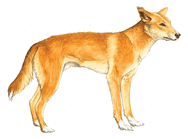 A wild dog, Canis lupus dingo, brought to Australia about 4000 years ago by Indonesian seafarers. Usually tawny-yellow in colour, with erect ears, a bushy tail and distinctive gait, and with a call resembling a howl or yelp rather than a bark.
A wild dog, Canis lupus dingo, brought to Australia about 4000 years ago by Indonesian seafarers. Usually tawny-yellow in colour, with erect ears, a bushy tail and distinctive gait, and with a call resembling a howl or yelp rather than a bark.
Linguists think that the term dingo was only used for the domesticated, camp dog.
See warrigal for the wild animal.
- dubbay, dub
- girlfriend, female partner
- doori ~ doot
- sex
- galah
- a fool , an idiot
 The bird referred to is the grey‑backed, pink‑breasted cockatoo Eolophus roseicapillus, occurring in all parts of Australia except the extreme north-east and south-west. Get out of it, you great bloody galah.
The bird referred to is the grey‑backed, pink‑breasted cockatoo Eolophus roseicapillus, occurring in all parts of Australia except the extreme north-east and south-west. Get out of it, you great bloody galah. first recorded in this context in the 1850s
- gammon
- to lie or tell fibs, to pretend, a fake
- This word has survived over the years as a part of First Nation language, from where it has now been re-adopted into Aussie English, epecially in areas close to First Nation communities, such as northern Australia.
- gibber
- a small stone suitable for throwing
- There are a number of similar words for this same item from all over the country, such as gonnie, all of which come from First Nation languages.
- goona
- shit
Wurundjeri
melbourne region
- gubba
- white person
- Usually used derogatorily.
diminutive: government ≈ gubba
- gunjies
- police
- gunyah
- hut, shelter
Dharuk
sydney region
- humpy
- rough bush shelter
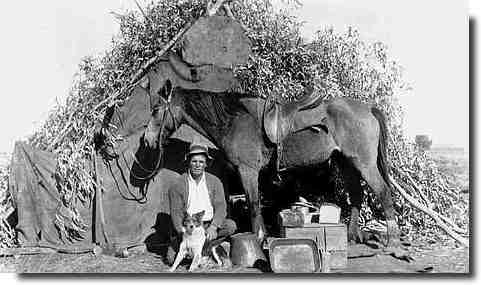 Originally a native dwelling, made of branches and bark (particularly paperbark), with a standing tree usually used as the main support.
Originally a native dwelling, made of branches and bark (particularly paperbark), with a standing tree usually used as the main support.
They are often built prior to the construction of more permanent buildings.
The term came to mean any temporary building made from available materials, including canvas, flattened metal drums, and sheets of corrugated iron.
Yagara
brisbane region
- jarrah
- hardwood tree, Eucalyptus Marginata
- kaya ⁓ palya ⁓ yaama
- hello
- koala
- a tailless, grey, furry, arboreal marsupial
 The koala, Phascolarctos cinereus of eastern Australia, is about 75 cm long.
The koala, Phascolarctos cinereus of eastern Australia, is about 75 cm long.
Although superficially similar to a small bear, there is no zoological justification for the expression koala bear.
- kookaburra
- a large kingfisher
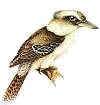 With a cry resembling laughter, the iconic aussie bird.
With a cry resembling laughter, the iconic aussie bird.
- kumanjayi
- substitute name for a dead person
Western Desert
central australia
about 600 000 square kilometres
- kurrajong
- bottle tree
- kylie
- a term for what is known elsewhere as a boomerang
- lingo
- language
- Watch your lingo in front of the children.
- lowan
- mallee fowl
- luderick
- black fish
Gunai
- mallee
- eucalypts with thick multi-stemmed roots
- marlu
- kangaroo

- marri
- red gum ( bloodwood tree ) native to wa
- mia mia
- hut
Gunai
south-east vic
- mish
- mission
Koori+ others
- mob
- any group of people or animals
- An aboriginal australian english word referring to any group sharing similar interests or peculiarities.
Mob o' sheep
They're a weird mob down in Melbourne.
Ring the mob that fixed our car.
- moolah
- money
 We've got enough moolah for a truckload of piss!
We've got enough moolah for a truckload of piss!
Koori+ others
- namma hole
- natural well in a rock
- nawa
- yes
Dhurga
nowra to jarvis bay nsw
- nulla-nulla, waddy
- wooden club, hunting stick
- numbat
- small, slender marsupial with white stripes on its back
- pademelons
- a small forest-dwelling macropod
- pukamani
- funeral rite
Tiwi
timor sea nt
- quandong
- an australian tree of the sandalwood family
 With a red fruit containing an edible kernel.
With a red fruit containing an edible kernel.
- quokka
- a short-tailed scrub wallaby
- rarrk
- cross-hatching design in art
Yolngu
arnhem land nt
- shame, shamejob
- that's embarrassing
- Sorry Business
- ceremony and rituals associated with the death of a loved one
- tidda
- girl, female friend, best friend
Koori+ others
- tjukurpa
- dreaming, traditional law
Western Desert
much of the desert of wa, sa, and the nt
- tuart
- large hardwood tree, eucalyptus gomphocephala
- unna
- that's right, yeah
- wallaby
- a small or mid-sized macropod
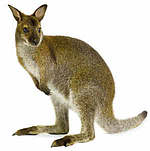 The young are known as joeys, like many other marsupials.
The young are known as joeys, like many other marsupials.
Adult males are referred to as bucks, boomers, or jacks.
Adult females are known as a doe, flyer, or jill.
A group is called a court, mob, or troupe.
Forest-dwellers are known as pademelonsAlthough most species are small, some can grow up to two metres from head to end of tail.
Their powerful hind legs are not only used for bounding at high speeds and jumping great heights, but also to administer vigorous kicks to fend off potential predators.
- wallaroo
- mountain kangaroo
- wallawani
- hello
Dhurga
nowra - jarvis bay
- waratah
- red-flowering tree ~ emblem of nsw
- warrigal
- wild dingo
 The term warrigal was applied to any wild animal.
The term warrigal was applied to any wild animal.
It eventually applied to anyone living in a wild state.
See dingo for the domesticated animal.
- wombat
- They are sturdy, stout marsupials that grow to about 1.3 metres long and weigh up to 35kg. They are very elusive and rarely leave their burrows before dusk.
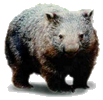 Sometimes their burrows are large enough for people to crawl through.
Sometimes their burrows are large enough for people to crawl through.
In 1878 a trooper hid in one from the Kelly gang.- Wombat Species
1 the southern hairy‑nosed wombat - Occurs in southern SA, south-eastern WA, and western Vic — the smallest of the three species.
2 the northern hairy‑nosed wombat - Lives in grasslands, and acacia and eucalyptus woodlands — the largest of the three species. It is now one of the rarest animals in the world, with only about 80 northern hairy‑nosed wombats living in central Qld.
3 the common wombat - Occurs in south-eastern Australia. It has coarse hair and a small tail.
- wonga wonga
- pigeon or vine
- woomera
- a type of throwing stick
- Traditionally used for hunting, with a notch at one end for holding a dart or spear, thus giving increased leverage in throwing.
- yabba ∼ yabber
- to talk too much
- Stop yabbering will ya?
- yabby
- a freshwater crayfish
Cherax Destructor is native to central and eastern mainland Australia, and have been introduced into WA and Tas.  Yabbies are also known throughout the country as crayfish or simply cray, not to be confused with lobsters or rock lobsters which are marine creatures.
Yabbies are also known throughout the country as crayfish or simply cray, not to be confused with lobsters or rock lobsters which are marine creatures.
The confusion arises from the fact that rock lobsters are called crayfish in Tas, SA, and NSW. Known colloquially by various regionalisms australia-wide such as lobsters, which is shortened to lobby in Qld, crawbob in NSW & Qld, crawchie in coastal Qld & north-east NSW, craybob in south Qld & NSW, and craydab in NSW & the ACT. The terms blackie , bluey , and greenie refer to different stages of development. In WA – where Cherax Destructor is a recent import – there are other native freshwater crayfish. The gilgie, pronounced with an initial soft g and also spelt jilgie, (colloquialised as joogie), the koonac, and the marron. To the neophyte they are often confused with the yabby and thus their names are used interchangeably.from the language wembawemba of central vic

- yakka
- hard work , especially manual labour
- That was hard yakka, mate.
Common usage is the colloquialism hard yakka , or in the phrase all yack and no yakka , describing someone who talks about what they're going to do instead of doing it.
Yagara/Yuggera
brisbane region
- yarraman
- horse
Yuggera, Wakawaka
s.e. qld
- yarran
- small hardy tree, often used as fodder and for firewood
- yidaki
- a wind instrument
- The instrument was originally used only in Arnhem Land, but became commonly known in Australia as the didgeridoo .
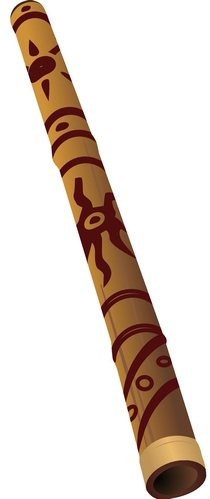 The Yolgnu word for the instrument has become widely known in recent decades, and was popularised by the music group Yothu Yindi, formed in 1986, whose members were Yolgnu speakers.
The Yolgnu word for the instrument has become widely known in recent decades, and was popularised by the music group Yothu Yindi, formed in 1986, whose members were Yolgnu speakers.
Yolngu
arnhem land nt
- yowie
- a mythical beast, an unidentified australian hominid
- One of several names for an Australian folklore entity reputed to live in the Outback.
One story about the name, a variant of yahoo, suggests that the creature is a part of the Dreamtime.
Akin to the sasquatch or yeti, and not to be confused with the bunyip.